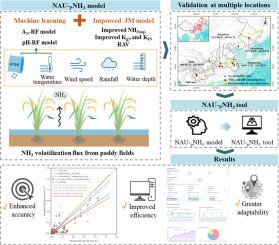基于机器学习和改进Jayaweera-Mikkelsen模型的混合模型模拟稻田水中NH3挥发
IF 5.7
1区 农林科学
Q1 AGRONOMY
引用次数: 0
摘要
NH3挥发是稻田生态系统氮损失的主要途径之一,准确量化其通量仍然是一个重大挑战,特别是在洪水条件下。为了解决这个问题,我们开发了一个名为NAU-PNH3的混合模型。该模型在原有Jayaweera-Mikkelsen (JM)模型的基础上,考虑了溶液活度系数、作物生长和降雨事件的影响,对NH3(aq)浓度和关键挥发函数(KgN和KIN)进行了改进。此外,该模型集成了机器学习(ML)算法,有效地模拟了水田水中的NH+4-N浓度(AN)和pH,从而提高了模型的整体性能。我们利用中国主要水稻产区四个代表性地点的实地观测,对原始模型和改进模型进行了综合评估。结果表明,NAU-PNH3模型在模拟水田NH3挥发通量方面优于原JM模型,显著降低了不确定性,提高了适应性。基于NAU-PNH3模型,我们开发了NAU-PNH3工具,这是一个模拟水田氨日挥发通量的在线平台。该模型提供了一种新的基于过程的模拟水田氨挥发的方法,为理解不同环境条件下氨损失的机制和动力学提供了有效的工具。本文章由计算机程序翻译,如有差异,请以英文原文为准。

A hybrid model based on machine learning and improved Jayaweera-Mikkelsen model to simulate NH3 volatilization in paddy field water
NH3 volatilization is one of the primary pathways of nitrogen loss in paddy field ecosystems, and accurately quantifying its flux remains a significant challenge, particularly under flooded conditions. To address this issue, we developed a hybrid model named NAU-PNH3. Based on the original Jayaweera-Mikkelsen (JM) model, this new model incorporates improvements in the NH3(aq) concentration and key volatilization functions (KgN and KIN), accounting for the effects of solution activity coefficients, crop growth, and rainfall events. In addition, the model integrates machine learning (ML) algorithms to efficiently simulate the NH+4-N concentrations (AN) and pH in paddy field water, thereby enhancing overall model performance. We conducted a comprehensive evaluation of the original and improved models using field observations from four representative sites across major rice-producing regions in China. The results demonstrated that the NAU-PNH3 model outperforms the original JM model in simulating NH3 volatilization fluxes from paddy fields, significantly reducing uncertainty and improving adaptability. Based on the NAU-PNH3 model, we developed the NAU-PNH3 Tool, an online platform for simulating daily NH3 volatilization flux in paddy fields. This model offers a novel process-based approach for simulating NH3 volatilization in paddy fields and provides an effective tool for understanding the mechanisms and dynamics of ammonia loss under varying environmental conditions.
求助全文
通过发布文献求助,成功后即可免费获取论文全文。
去求助
来源期刊
CiteScore
10.30
自引率
9.70%
发文量
415
审稿时长
69 days
期刊介绍:
Agricultural and Forest Meteorology is an international journal for the publication of original articles and reviews on the inter-relationship between meteorology, agriculture, forestry, and natural ecosystems. Emphasis is on basic and applied scientific research relevant to practical problems in the field of plant and soil sciences, ecology and biogeochemistry as affected by weather as well as climate variability and change. Theoretical models should be tested against experimental data. Articles must appeal to an international audience. Special issues devoted to single topics are also published.
Typical topics include canopy micrometeorology (e.g. canopy radiation transfer, turbulence near the ground, evapotranspiration, energy balance, fluxes of trace gases), micrometeorological instrumentation (e.g., sensors for trace gases, flux measurement instruments, radiation measurement techniques), aerobiology (e.g. the dispersion of pollen, spores, insects and pesticides), biometeorology (e.g. the effect of weather and climate on plant distribution, crop yield, water-use efficiency, and plant phenology), forest-fire/weather interactions, and feedbacks from vegetation to weather and the climate system.

 求助内容:
求助内容: 应助结果提醒方式:
应助结果提醒方式:


